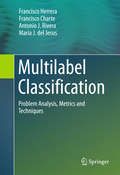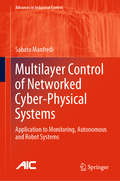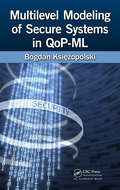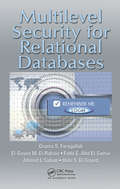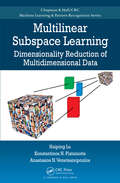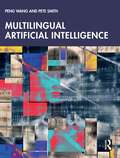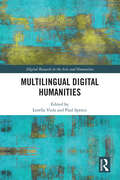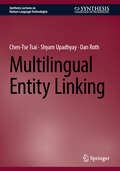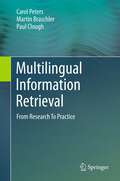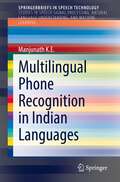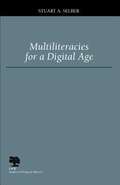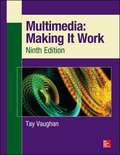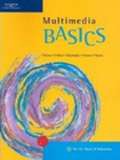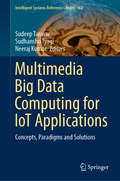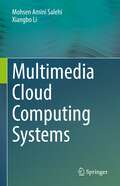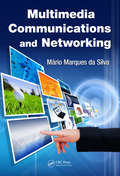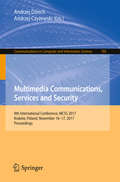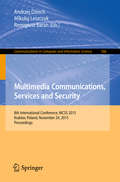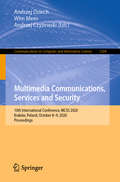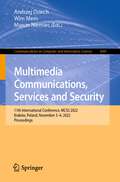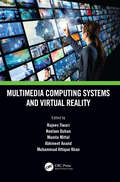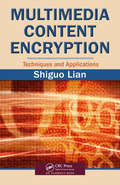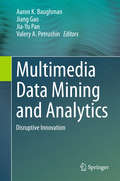- Table View
- List View
Multilabel Classification
by Francisco Herrera Francisco Charte Antonio J. Rivera María J. JesusThis book offers a comprehensive review of multilabel techniques widely used to classify and label texts, pictures, videos and music in the Internet. A deep review of the specialized literature on the field includes the available software needed to work with this kind of data. It provides the user with the software tools needed to deal with multilabel data, as well as step by step instruction on how to use them. The main topics covered are: * The special characteristics of multi-labeled data and the metrics available to measure them. * The importance of taking advantage of label correlations to improve the results. * The different approaches followed to face multi-label classification. * The preprocessing techniques applicable to multi-label datasets. * The available software tools to work with multi-label data. This book is beneficial for professionals and researchers in a variety of fields because of the wide range of potential applications for multilabel classification. Besides its multiple applications to classify different types of online information, it is also useful in many other areas, such as genomics and biology. No previous knowledge about the subject is required. The book introduces all the needed concepts to understand multilabel data characterization, treatment and evaluation.
Multilayer Control of Networked Cyber-Physical Systems: Application to Monitoring, Autonomous and Robot Systems (Advances in Industrial Control)
by Sabato ManfrediThis book faces the interdisciplinary challenge of formulating performance-assessing design approaches for networked cyber-physical systems (NCPSs). Its novel distributed multilayer cooperative control deals simultaneously with communication-network and control performance required for the network and application layers of an NCPS respectively. Practically, it distributes the computational burden among different devices, which act cooperatively to achieve NCPS goals. The approach can be applied to NCPSs based on both wired and wireless technologies and so is suitable for future network infrastructures in which different protocols and technologies coexist. The book reports realistic results from performance evaluation of the new approach, when applied in different operative scenarios. Readers of this book will benefit by: learning a general, technology-independent methodology for the design and implementation of cooperative distributed algorithms for flow control at the network layer of an NCPS that gives algorithm-parameter-tuning guidelines for assessing the desired quality of service performance; learning a general methodology for the design and implementation of consensus-based algorithms at the application layer that allows monitoring and control of distributed physical systems and gives algorithm-parameter-tuning guidelines for assessing the desired control system performance; understanding the main network simulators needed to validate the effectiveness of the proposed multilayer control approach in different realistic network operation scenarios; and practising with a cooperative multilayer control project that assesses acceptable NCPS performance in networked monitoring and robot systems, autonomous and queuing networks, and other critical human relief applications. Researchers, graduate students and practitioners working in automation, engineering, sensor networks, mobile robotics and computer networks will find this book instructive. It will also be helpful to network administrators and technicians implementing application-layer and network-layer solutions or installing, configuring or troubleshooting network and control system components of NCPSs.
Multilevel Modeling of Secure Systems in QoP-ML
by Bogdan KsiezopolskiIn order to perform effective analysis of today's information security systems, numerous components must be taken into consideration. This book presents a well-organized, consistent solution created by the author, which allows for precise multilevel analysis of information security systems and accounts for all of the significant details. Enabling t
Multilevel Security for Relational Databases
by Osama S. Faragallah El-Sayed M. El-Rabaie Fathi E. El-Samie Ahmed I. Sallam Hala S. El-SayedSince databases are the primary repositories of information for today's organizations and governments, database security has become critically important. Most database security models focus on protecting against external unauthorized users. Because multilevel secure databases provide internal security according to user access type, they are a viable option for the security needs of modern database systems. Covering key concepts in database security, this book illustrates the implementation of multilevel security for relational database models. It considers concurrency control in multilevel database security and presents encryption algorithms. It also includes simulation programs and Visual studio and Microsoft SQL Server code for the simulations covered in the text.
Multilinear Subspace Learning: Dimensionality Reduction of Multidimensional Data (Chapman & Hall/CRC Machine Learning & Pattern Recognition)
by Haiping Lu Konstantinos N. Plataniotis Anastasios VenetsanopoulosDue to advances in sensor, storage, and networking technologies, data is being generated on a daily basis at an ever-increasing pace in a wide range of applications, including cloud computing, mobile Internet, and medical imaging. This large multidimensional data requires more efficient dimensionality reduction schemes than the traditional techniqu
Multilingual Artificial Intelligence
by Pete Smith Peng WangMultilingual Artificial Intelligence is a guide for non-computer science specialists and learners looking to explore the implementation of AI technologies to solve real-life problems involving language data.Focusing on multilingual, multicultural, pre-trained large language models and their practical use through fine-tuning and prompt engineering, Wang and Smith demonstrate how to apply this new technology in areas such as information retrieval, semantic webs, and retrieval augmented generation, to improve both human productivity and machine intelligence. Finally, they discuss the human impact of language technologies in the cultural context, and provide an AI competence framework for users to design their own learning journey.This innovative text is essential reading for all students, professionals, and researchers in language, linguistics, and related areas looking to understand how to integrate multilingual and multicultural artificial intelligence technology into their research and practice.
Multilingual Digital Humanities (Digital Research in the Arts and Humanities)
by Paul Spence Lorella ViolaMultilingual Digital Humanities explores the impact of monolingualism—especially Anglocentrism—on digital practices in the humanities and social sciences. The volume explores a wide range of applied contexts, such as digital linguistic injustice, critical digital literacy, digital learning, digital publishing, low-resourced, minoritised or endangered languages in a digital space, and multilingual historical intertextuality. These discussions are situated within wider work on language technologies, language documentation and international (in particular European) language-based infrastructure creation. Drawing on both primary and secondary research, this four-part book features 13 diverse case studies of infrastructural projects, pedagogical resources, computational models, interface building, and publishing initiatives in a range of languages, including Arabic, French, Russian, Portuguese, Italian, German, Spanish, Bengali, Hindi, Malayalam, and Tamil. All the debates are contextualised within a wider cultural frame, thus bridging the gap between the linguistic focus of the multilingual initiatives and wider discussion of cultural criticism in DH. Multilingual Digital Humanities recognizes the digital as a culturally situated and organic multilingual entity embedding past, present, and future worlds, which reacts to and impacts on institutional and methodological frameworks for knowledge creation. It is essential reading for students, scholars, and practitioners working in digital humanities and digital studies.
Multilingual Digital Humanities (ISSN)
by Paul Spence Lorella ViolaMultilingual Digital Humanities explores the impact of monolingualism—especially Anglocentrism—on digital practices in the humanities and social sciences.The volume explores a wide range of applied contexts, such as digital linguistic injustice, critical digital literacy, digital learning, digital publishing, low-resourced, minoritised or endangered languages in a digital space, and multilingual historical intertextuality. These discussions are situated within wider work on language technologies, language documentation and international (in particular European) language-based infrastructure creation. Drawing on both primary and secondary research, this four-part book features 13 diverse case studies of infrastructural projects, pedagogical resources, computational models, interface building, and publishing initiatives in a range of languages, including Arabic, French, Russian, Portuguese, Italian, German, Spanish, Bengali, Hindi, Malayalam, and Tamil. All the debates are contextualised within a wider cultural frame, thus bridging the gap between the linguistic focus of the multilingual initiatives and wider discussion of cultural criticism in DH. Multilingual Digital Humanities recognizes the digital as a culturally situated and organic multilingual entity embedding past, present, and future worlds, which reacts to and impacts on institutional and methodological frameworks for knowledge creation. It is essential reading for students, scholars, and practitioners working in digital humanities and digital studies.
Multilingual Entity Linking (Synthesis Lectures on Human Language Technologies)
by Dan Roth Chen-Tse Tsai Shyam UpadhyayThis book focuses on Entity Discovery and Linking (EDL), which is the problem of identifying concepts and entities, disambiguating them, and grounding them to one or more knowledge bases (KBs). The authors first provide background on the topic and emphasize why it is a crucial step toward understanding natural language text. As most of the content on the internet is not in English, the book also discusses cross-lingual EDL. The authors present the challenges associated with EDL problems and explain the existing solutions. The book covers the core challenges that apply to all EDL problems, as well as the additional challenges associated with cross-lingual EDL problems. The authors also survey relevant research papers, highlight recent trends, and identify areas for future research.
Multilingual Information Retrieval
by Carol Peters Martin Braschler Paul CloughWe are living in a multilingual world and the diversity in languages which are used to interact with information access systems has generated a wide variety of challenges to be addressed by computer and information scientists. The growing amount of non-English information accessible globally and the increased worldwide exposure of enterprises also necessitates the adaptation of Information Retrieval (IR) methods to new, multilingual settings. Peters, Braschler and Clough present a comprehensive description of the technologies involved in designing and developing systems for Multilingual Information Retrieval (MLIR). They provide readers with broad coverage of the various issues involved in creating systems to make accessible digitally stored materials regardless of the language(s) they are written in. Details on Cross-Language Information Retrieval (CLIR) are also covered that help readers to understand how to develop retrieval systems that cross language boundaries. Their work is divided into six chapters and accompanies the reader step-by-step through the various stages involved in building, using and evaluating MLIR systems. The book concludes with some examples of recent applications that utilise MLIR technologies. Some of the techniques described have recently started to appear in commercial search systems, while others have the potential to be part of future incarnations. The book is intended for graduate students, scholars, and practitioners with a basic understanding of classical text retrieval methods. It offers guidelines and information on all aspects that need to be taken into consideration when building MLIR systems, while avoiding too many 'hands-on details' that could rapidly become obsolete. Thus it bridges the gap between the material covered by most of the classical IR textbooks and the novel requirements related to the acquisition and dissemination of information in whatever language it is stored.
Multilingual Phone Recognition in Indian Languages (SpringerBriefs in Speech Technology)
by K.E ManjunathThe book presents current research and developments in multilingual speech recognition. The author presents a Multilingual Phone Recognition System (Multi-PRS), developed using a common multilingual phone-set derived from the International Phonetic Alphabets (IPA) based transcription of six Indian languages - Kannada, Telugu, Bengali, Odia, Urdu, and Assamese. The author shows how the performance of Multi-PRS can be improved using tandem features. The book compares Monolingual Phone Recognition Systems (Mono-PRS) versus Multi-PRS and baseline versus tandem system. Methods are proposed to predict Articulatory Features (AFs) from spectral features using Deep Neural Networks (DNN). Multitask learning is explored to improve the prediction accuracy of AFs. Then, the AFs are explored to improve the performance of Multi-PRS using lattice rescoring method of combination and tandem method of combination. The author goes on to develop and evaluate the Language Identification followed by Monolingual phone recognition (LID-Mono) and common multilingual phone-set based multilingual phone recognition systems.
Multiliteracies for a Digital Age
by Stuart A. SelberThis is a guide for composition teachers to develop effective, full-scale computer literacy programs that are also professionally responsible by emphasizing different kinds of literacies and proposing methods for helping students move among them in strategic ways.
Multimedia - Making It Work
by Tay VaughanThe Most Complete, Up-to-Date Multimedia Guide Thoroughly updated to cover the latest technologies, including mobile multimedia, this full-color resource prepares you for a successful multimedia career by teachingyou the fundamental concepts and required skills. Multimedia: Making It Work, Ninth Edition explains how to integrate text, images, sound, animation, and video into compelling projects. Multimedia project planning, costs, design, production, talent acquisition, testing, and delivery are also discussed. Chapter-ending quizzes reinforce key concepts and hands-on lab projects allow you to apply your new skills. Learn how to: Master the essential elements of multimedia, including text, images, sound, animation, and video Incorporate bitmap, vector, and 3-D images Record and edit digital audio and use MIDI Create computer-generated animations Shoot and edit digital video Select the best hardware, software, and authoring tools for your project Determine the scope and cost of a multimedia projectn Design, produce, and test your project Acquire the best content and talent for your budget Design dynamic Web content Create apps for mobile devices, including tablets, readers, and smartphones Deliver multimedia over the Internet, in an app store, and on CD-ROM and DVD Each chapter includes: Learning objectives Full-color illustrations and screenshots Helpful notes, tips, and warnings Chapter summaries and key term lists End-of-chapter quizzes and lab projects This book is intended for students enrolled in an instructor-led course and does not provide correct answers for the end-of-chapter quizzes or access to the instructor's resource materials. If you are an instructor, please contact your McGraw-Hill Education sales representative for details.
Multimedia Basics
by Jennifer Fulton Suzanne Weixel Karl Barksdale Cheryl Morse Bryan MorseAn excellent foundation for any multimedia or website design curriculum, this textbook provides comprehensive coverage of many multimedia topics including graphics, animation, video, presentations, desktop publishing, and web pages.
Multimedia Big Data Computing for IoT Applications: Concepts, Paradigms and Solutions (Intelligent Systems Reference Library #163)
by Neeraj Kumar Sudeep Tanwar Sudhanshu TyagiThis book considers all aspects of managing the complexity of Multimedia Big Data Computing (MMBD) for IoT applications and develops a comprehensive taxonomy. It also discusses a process model that addresses a number of research challenges associated with MMBD, such as scalability, accessibility, reliability, heterogeneity, and Quality of Service (QoS) requirements, presenting case studies to demonstrate its application. Further, the book examines the layered architecture of MMBD computing and compares the life cycle of both big data and MMBD. Written by leading experts, it also includes numerous solved examples, technical descriptions, scenarios, procedures, and algorithms.
Multimedia Cloud Computing Systems
by Mohsen Amini Salehi Xiangbo LiThe second generation of cloud computing systems, known as domain-specific clouds, are emerging based on application-specific processors and serverless computing paradigm. As multimedia streaming services are increasingly growing in popularity and diversity, this book is authored to introduce “multimedia clouds” as a domain-specific cloud that operates in the intersection of cloud computing technologies and digital media streaming. The book concentrates on the architectural aspects of multimedia clouds and describes development of high-level abstractions that will mitigate the burden of programmers, cloud architects, and system administrators. Multimedia clouds not only democratize multimedia streaming and add flexibility to the streaming services, they also help stream providers to offer robust and reliable streaming services in a cost- and energy-efficient manner.
Multimedia Communications and Networking
by Mario Marques da SilvaThe result of decades of research and international project experience, Multimedia Communications and Networking provides authoritative insight into recent developments in multimedia, digital communications, and networking services and technologies. Supplying you with the required foundation in these areas, it illustrates the means that will allow
Multimedia Communications, Services and Security
by Andrzej Dziech Andrzej CzyżewskiThis book constitutes the refereed proceedings of the 4th International Conference on Multimedia Communications, Services and Security, MCSS 2011, held in Krakow, Poland, in June 2011. The 42 revised full papers presented were carefully reviewed and selected from numerous submissions. Topics addresses are such as audio-visual systems, service oriented architectures, multimedia in networks, multimedia content, quality management, multimedia services, watermarking, network measurement and performance evaluation, reliability, availability, serviceability of multimedia services, searching, multimedia surveillance and compound security, semantics of multimedia data and metadata information systems, authentication of multimedia content, interactive multimedia applications, observation systems, cybercrime-threats and counteracting, law aspects, cryptography and data protection, quantum cryptography, object tracking, video processing through cloud computing, multi-core parallel processing of audio and video, intelligent searching of multimedia content, biometric applications, and transcoding of video.
Multimedia Communications, Services and Security
by Andrzej Dziech Mikołaj Leszczuk Remigiusz BaranThis volume constitutes the refereed proceedings of the 8th International Conference on Multimedia Communications, Services and Security, MCSS 2015, held in Krakow, Poland, in November 2015. The 16 full papers included in the volume were selected from 39 submissions. The papers cover ongoing research activities in the following topics: multimedia services; intelligent monitoring; audio-visual systems; biometric applications; experiments and deployments.
Multimedia Communications, Services and Security: 10th International Conference, MCSS 2020, Kraków, Poland, October 8-9, 2020, Proceedings (Communications in Computer and Information Science #1284)
by Andrzej Dziech Andrzej Czyżewski Wim MeesThis volume constitutes the refereed proceedings of the 10th International Conference on Multimedia Communications, Services and Security, MCSS 2020, held in Kraków, Poland, in October 2020. The 24 full papers and 2 short papers included in the volume were selected from 54 submissions. The papers cover ongoing research activities in the following topics: multimedia services; intelligent monitoring; audio-visual systems; biometric applications; experiments and deployments.
Multimedia Communications, Services and Security: 11th International Conference, MCSS 2022, Kraków, Poland, November 3–4, 2022, Proceedings (Communications in Computer and Information Science #1689)
by Andrzej Dziech Wim Mees Marcin NiemiecThis book constitutes the proceedings of the 11th International Conference, MCSS 2022, held in Kraków, Poland, during November 3–4, 2022. The 13 full papers included in this book were carefully reviewed and selected from 33 submissions. The papers cover ongoing research activities in the following topics: cybersecurity, multimedia services; intelligent monitoring; audio-visual systems; biometric applications; experiments and deployments.
Multimedia Computing
by Gerald Friedland Ramesh JainThe word 'multimedia' is often associated with specific applications from entertainment to web design to video to music. This innovative textbook presents emerging techniques in multimedia computing from an experiential perspective in which each medium - audio, images, text, and so on - is a strong component of the complete, integrated exchange of information or experience. Humans are the best functioning example of multimedia communication and computing – that is, we understand information and experiences through the unified perspective offered by our five senses. The goal of this book is to present current techniques in computing and communication that will lead to the development of a unified and holistic approach to computing using heterogeneous data sources. The authors introduce the fundamentals of multimedia computing, describing the properties of perceptually encoded information, presenting common algorithms and concepts for handling it, and outlining the typical requirements for emerging applications that use multifarious information sources. Designed for advanced undergraduate and beginning graduate courses, the book will also serve as an introduction for engineers and researchers interested in understanding the elements of multimedia and their role in building specific applications.
Multimedia Computing Systems and Virtual Reality (Innovations in Multimedia, Virtual Reality and Augmentation)
by Rajeev TiwariMost events and activities in today's world are ordinarily captured using photos, videos and other multimedia content. Such content has some limitation of storing data and fetching them effectively. Three-dimensional continuous PC animation is the most proper media to simulate these occasions and activities. This book focuses on futuristic trends and innovations in multimedia systems using big data, IoT and cloud technologies. The authors present recent advancements in multimedia systems as they relate to various application areas such as healthcare services and agriculture-related industries. The authors also discuss human-machine interface design, graphics modelling, rendering/animation, image/graphics techniques/systems and visualization. They then go on to explore multimedia content adaptation for interoperable delivery. Finally, the book covers cultural heritage, philosophical/ethical/societal/international issues, standards-related virtual technology and multimedia uses. This book is intended for computer engineers and computer scientists developing applications for multimedia and virtual reality and professionals working in object design and visualization, transformation, modelling and animation of the real world. Features: Focuses on futuristic trends and innovations in multimedia systems using big data, IoT and cloud technologies Offers opportunity for state-of-the-art approaches, methodologies and systems, and innovative use of multimedia-based emerging technology services in different application areas Discusses human-machine interface design, graphics modelling, rendering/animation, image/graphics techniques/systems and visualization Covers cultural heritage, philosophical/ethical/societal/international issues, standards-related virtual technology and multimedia uses Explores multimedia content adaptation for interoperable delivery and recent advancements in multimedia systems in context to various application areas such as healthcare services and agriculture-related fields Rajeev Tiwari is a Senior Associate Professor in the School of Computer Science at the University of Petroleum and Energy Studies, Dehradun, India. Neelam Duhan is an Associate Professor in the Department of Computer Engineering at J. C. Bose University of Science and Technology, YMCA, Faridabad, India. Mamta Mittal has 18 years of teaching experience, and her research areas include data mining, big data, machine learning, soft computing and data structure. Abhineet Anand is a Professor in the Computer Science and Engineering Department at Chitkara University, Punjab, India. Muhammad Attique Khan is a lecturer of the Computer Science Department at HITEC University, Taxila, Pakistan.
Multimedia Content Encryption: Techniques and Applications
by Shiguo LianThe widespread use of image, audio, and video data makes media content protection increasingly necessary and urgent. For maximum safety, it is no longer sufficient to merely control access rights. In order to fully protect multimedia data from piracy or unauthorized use, it must be secured through encryption prior to its transmission or distributio
Multimedia Data Mining and Analytics
by Aaron K. Baughman Jiang Gao Jia-Yu Pan Valery A. PetrushinThis book provides fresh insights into the cutting edge of multimedia data mining, reflecting how the research focus has shifted towards networked social communities, mobile devices and sensors. The work describes how the history of multimedia data processing can be viewed as a sequence of disruptive innovations. Across the chapters, the discussion covers the practical frameworks, libraries, and open source software that enable the development of ground-breaking research into practical applications. Features: reviews how innovations in mobile, social, cognitive, cloud and organic based computing impacts upon the development of multimedia data mining; provides practical details on implementing the technology for solving real-world problems; includes chapters devoted to privacy issues in multimedia social environments and large-scale biometric data processing; covers content and concept based multimedia search and advanced algorithms for multimedia data representation, processing and visualization.
